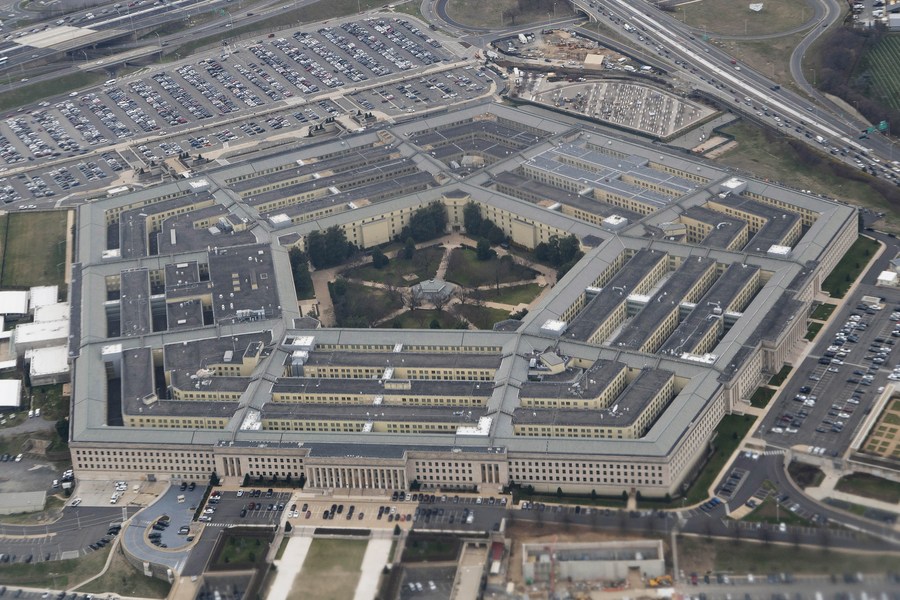Cold War-minded U.S. eyes more military spending to sustain hegemony amid geopolitical tensions
* The comprehensive budget plan totaling 5.8 trillion U.S. dollars includes 813.3 billion dollars for "national defense," of which 773 billion is allocated for the U.S. Department of Defense.
* A large amount of U.S. military funding has been poured into its operations overseas.
* The United States has also thrown trillions of dollars at the research and development of new-generation weapon systems.
WASHINGTON, March 28 (Xinhua) -- Amidst the Ukraine crisis and surging domestic inflation, the White House unveiled on Monday a budget plan for the fiscal year 2023 calling for a boost in military spending.
Though it is a mere wish as lawmakers make the final decisions on U.S. budget, this attempt of the U.S. administration continued a dangerous trend of America's relentless drive to boost its military capabilities and presence around the globe, which is likely to add more risks and uncertainties to the world's geopolitical tensions.

Photo taken on March 28, 2022 shows the Capitol building in Washington, D.C., the United States. (Xinhua/Liu Jie)
EXCESSIVE SPENDING
The comprehensive budget plan totaling 5.8 trillion U.S. dollars includes 813.3 billion dollars for "national defense," of which 773 billion is allocated for the U.S. Department of Defense. The number is an increase of 30.7 billion dollars, or 4.1 percent, for the Pentagon from what has been enacted for the previous fiscal year.
"I'm calling for one of the largest investments in our national security in history, with the funds needed to ensure that our military remains the best-prepared, best-trained, best-equipped military in the world," U.S. President Joe Biden said in a statement.
His budget also includes 6.9 billion dollars for the North Atlantic Treaty Organization (NATO), and aid to Ukraine, among other things.
"The hawks in Washington want to jack up the military budget and use Ukraine as an excuse" and the proposed military spending was more than what was spent "at the height of the Korean or Vietnam Wars" as well as that of the Cold War, commented William Hartung, a senior research fellow at the Washington, D.C.-based think tank Quincy Institute for Responsible Statecraft.
As the world's largest military spender, the United States accounted for 39 percent of global military expenditure in 2020, according to data published by the Stockholm International Peace Research Institute in 2021. It also spent more on defense than the next 11 countries combined in 2020, up from outspending the next 10 countries combined in 2019.
"This level of spending has long been excessive, but after a pandemic that has claimed the lives of more Americans than any war we fought, continuing to throw money at the military is an act of willful disregard for the most urgent threats we face," Farhad Manjoo, an opinion columnist for The New York Times, wrote in a piece earlier this year.
While the United States has spent recklessly fighting wars and managing the armed forces, "we can't even keep our infrastructure in the U.S. intact ... We do not have a government of, by, for the people," Daniel Kovalik, an adjunct professor of law at the University of Pittsburgh, moaned when talking to Xinhua.

Photo taken on Feb. 19, 2020 shows the Pentagon seen from an airplane over Washington D.C., the United States. (Xinhua/Liu Jie)
CONSTANT WARS
A large amount of U.S. military funding has been poured into its operations overseas.
According to the Congressional Research Service -- a public policy research institute of the U.S. Congress -- and other sources, U.S. armed forces military has waged war, engaged in combat, or otherwise invaded foreign territories in all but 11 years of its existence. Depending on one's definitions, the years at peace may be even fewer.
"Some assume, as I did, that it's unusual that most new U.S. military recruits and most new U.S. college students have no memory of a time when their country wasn't at war," David Vine wrote in his book "The United States of War: A Global History of America's Endless Conflicts, from Columbus to the Islamic State."
"To the contrary, this state of war is the norm in U.S. history," Vine observed.
Besides, the United States has intervened in a series of conflicts by supporting a proxy with weapons, funding, and training, leading to tremendous casualties, as well as humanitarian tragedies and disasters. Some countries still at war consequently are struggling to find a path to peace and stability, let alone reconstruction and revival.
America's obsession with warfare and high military spending has been largely driven by the nation's military-industrial complex -- a powerful union of the military, private defense contractors, and politicians. Certain think tanks and journalists have often collaborated with them to spread and shape pro-war narratives.
Kovalik said he believes the military-industrial complex is eager to see the conflicts between Russia and Ukraine go on because "that's great for the defense industry" whose stocks have recently gone "through the roof."
"That's why the U.S. is not engaged in the peace discussions because they just want to continue the war. And that will mean more armaments to Ukraine, more armaments to countries like Poland, more armaments to NATO, again, many of which will be blown up and that will require even more armaments and more profits," Kovalik explained.
Hartung added the proposed budget boost by the White House "is only going to benefit weapons contractors and members of Congress who receive campaign contributions from them, who use the arguments to get themselves elected."

A U.S. military vehicle runs past the Tal Tamr area in the countryside of Hasakah province, northeastern Syria, Nov. 14, 2019.
SUSTAINING HEGEMONY
For the past several decades, the United States has also been beefing up its global military presence to sustain its hegemony.
"There is no enemy. We defined new enemies and we created them," observed Peter Kuznick, director of the Nuclear Studies Institute at American University. "This was just part of the U.S. global agenda. The U.S. doesn't win these wars ... They allow the U.S. to maintain hegemony."
To that end, the United States has set up approximately 750 military base sites in 80 foreign countries and territories, according to a study published by the Quincy Institute for Responsible Statecraft in 2021. Those U.S. bases cost an estimated 55 billion dollars annually.
"U.S. bases in foreign lands often raise geopolitical tensions, support undemocratic regimes, and serve as a recruiting tool for militant groups opposed to the U.S. presence and the governments its presence bolsters," said Vine and two other researchers in a summary of the study.
"In other cases, foreign bases are being used and have made it easier for the United States to launch and execute disastrous wars, including those in Afghanistan, Iraq, Yemen, Somalia, and Libya," they said.
The United States has also thrown trillions of dollars at the research and development of new-generation weapon systems.
For example, an official Pentagon estimate showed that the F-35 program, tasked with delivering the next-generation combat aircraft, is expected to cost a total of 1.7 trillion dollars across the fleet's lifecycle. It costs up to 36,000 dollars per hour to fly the stealth jet.
U.S. Congressman and Chairman of the House Armed Services Committee Adam Smith has been a vocal critic of the most expensive weapons system in history, calling F-35s a "rathole" in a virtual event last year, while describing the Pentagon's acquisition process over the last 20 years as "a complete disaster."
Photos
 Increasingly more young adults in China register wills that include virtual assets
Increasingly more young adults in China register wills that include virtual assets Rapeseed flowers turn NW China's Luoping into picturesque spring wonderland
Rapeseed flowers turn NW China's Luoping into picturesque spring wonderland Why do people in China fall for animated characters like LinaBell and Bing Dwen Dwen?
Why do people in China fall for animated characters like LinaBell and Bing Dwen Dwen? Photo Album: architecture in Beijing merging history and modernity
Photo Album: architecture in Beijing merging history and modernity
Related Stories
Copyright © 2022 People's Daily Online. All Rights Reserved.






